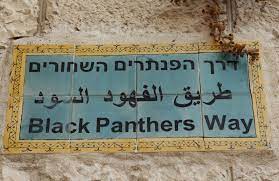Quickly…When you picture the Black Panthers, what comes to mind? Maybe it’s an image… or thoughts of Black pride. I mean that’s what I always thought of. But in the Jewish state, the term Black Panthers means something else entirely.
The Israeli Black Panthers, or the Panterim Shchorim, shaped the evolution of multiculturalism in Israel. It’s a fascinating story, and I’m pumped to share it with you.

Are you familiar with the Israeli club scene? Well, the Panterim are partially responsible for it. But it’s not because of their fashion sense. To understand the connection, let’s rewind to 1948.
When Prime Minister David Ben-Gurion declared independence on May 14, 1948, the State of Israel boasted a Jewish population of 600,000. By the end of 1952, that population had more than doubled. In the world’s most chaotic family reunion, over 700,000 Jews from all over the globe had come home.
Those who came from Europe were called Ashkenazim — think Yiddish, Klezmer, and Hasidim. The majority of Israel’s founders were Ashkenazi. Like Herzl, the father of modern Zionism. Naftali Herz Imber, who wrote Israel’s national anthem Hatikvah. David Ben Gurion…and every Prime Minister since.
But Ashkenazim were only half the story. The other half were the Mizrahim. Literally, “Easterners.” These are Jews from Muslim lands, many of whom arrived in Israel with little more than the clothes on their backs, their assets stolen by hostile governments.
In the state’s early years, most Israelis lived modestly. Whether Mizrahi or Ashkenazi, the state’s early years were hard. Many new immigrants lived in ma’abarot, or transit camps, usually without water or electricity. Yet it was hard not to notice that 80% of the ma’abarot were Mizrahi. That the government tried to make alternative arrangements for Ashkenazim.
It was also hard not to notice the Ashkenazi attitude toward Mizrahim. A 1951 newspaper article criticized Mizrahim as “people with no will for work . . . [who] lack any understanding and patience to get over the necessary conditions here.” Prime Minister Ben Gurion himself admitted: “It’s true. There’s discrimination. It’s necessary.”
Though… he never exactly explained why.
Tensions smoldered, finally catching fire in 1959. Police entered a Mizrahi neighborhood in Haifa and shot a local drunk, leaving him paralyzed. Enraged, Mizrahi protestors marched on a wealthy Ashkenazi neighborhood, breaking windows and setting cars on fire. In response, the government evacuated the neighborhood. It would take another 12 years for anything to change.
That change came from an unlikely source: the majority-Mizrahi neighborhood of Musrara. This Jerusalem slum was overcrowded and under-resourced. Work was scarce. Youth had few prospects. Many had lived in substandard conditions since arriving in Israel. They watched bitterly as recent Ashkenazi immigrants were given large apartments, generous government loans, and access to social services. Finally, a group of young men decided to do something about it.
These were the Israeli Black Panthers, HaPanterim HaSchorim: Charlie Biton, Sa’adia Marciano, Reuven Abergel, and Kochavi Shemesh. They found inspiration in another struggle from thousands of miles away.
The Israeli Panthers were well aware that America’s Black community fought a VERY different kind of oppression. There were no Jim Crow laws in Israel. No legacy of slavery. No lynch mobs. But governmental neglect? Generational poverty? The suppression of Mizrahi culture? That was a familiar song.
The American Black Panthers were provocative. Especially when it came to the Arab-Israeli conflict. Because the American Panthers were pretty anti-Israel. Their newspaper ran editorials by Yasser Arafat, head of the PLO. Side note: Arafat has a complicated legacy. But in the 70s, his organization’s primary purpose was conducting terror attacks within Israel.
So why would the Panterim model themselves after an anti-Zionist and often antisemitic group? Founding member Kochavi Shemesh explained: “The idea was to frighten Golda. She said that this name wouldn’t let her sleep. That was what we wanted.”
The name was a big middle finger to the Israeli government. In March of 1971, the Panterim began their campaign to frighten Golda Meir. To raise awareness. To force the Israeli government to do something about the Mizrahi plight. And three days after the first demonstration, the cabinet agreed to release extra funds for social programs.
A daily newspaper proclaimed, “The ‘Panterim’ Helped the Cabinet ‘Find’ the Budget.” But the Panterim was just getting started. A month later, they staged a hunger strike at the Western Wall, demanding an audience with Prime Minister Golda Meir.
Want to hear something crazy? It actually worked. The founding members were invited to meet with Golda! They brought a list of 33 demands. But the meeting was tense. One account reports that a founding member of the Panthers called the prime minister a liar to her face. The Panterim left the meeting frustrated and empty-handed.
Soon, their protests grew increasingly violent. Thousands attended the so-called “Night of the Panterim” in May of ‘71. The demonstration spiraled out of control, as police turned water cannons and clubs on protestors and protesters lobbed Molotov cocktails at police.
It was this violent protest that led Golda Meir to remark that the Panterim were “not nice guys.” She was mocked mercilessly. There’s a street in Musrara literally named “They’re Not Nice Alley,” a scornful homage to this moment.
But the mockery ignores the full context of the quote, which was, quote, “People who throw Molotov Cocktails at Jewish police aren’t nice guys.” Golda wasn’t decrying the Panterim’s lack of social niceties, but their violence.
Still, her soundbite became a rallying cry. A badge of honor. Golda, 0. Panterim, 1. The Panterim were excellent at PR. They staged memorable stunts, like “liberating” milk from a rich neighborhood to feed Mizrahi children in the Jerusalem slums.
But a one-time stunt isn’t systemic change. Worse, the Panterim never agreed on their politics. Some were passionate Zionists, demanding to end meetings with Israel’s national anthem, HaTikva. Others were Marxists who made common cause with the PLO. The lack of a coherent ideology muddled the movement’s aims, making it hard to get things done.
The 1973 Yom Kippur War — in which Egypt and Syria attacked Israel on the holiest day of the year — was the nail in the movement’s coffin. The demonstrations dried up. The solidarity died. No one had the luxury of focusing on internal divisions when external threats loomed so large.
But the movement’s spirit lingered in Israeli politics. Two founding members went on to serve in the Knesset. Others became civil rights lawyers. And six years after the Panthers’ first protest, an Ashkenazi politician saw the power of the Mizrahi bloc. Menahem Begin reached out to the long-ignored Mizrahi community, and they voted his party into office, ushering in a new age of Israeli politics. By 1984, the Knesset boasted a religious Mizrahi party.
Slowly, Mizrahi representation began to rise. In politics. In the army. In academia. In popular culture. By the 90s, Mizrahi music dominated the airwaves. Once, Mizrahi artists had been denied radio airtime, their music relegated to bootleg cassettes. Today, “Israeli music” and “Mizrahi music” are nearly synonymous.
Mizrahi food and traditions are a familiar and beloved part of the cultural landscape. Slowly, Israel has reclaimed its identity as a Middle Eastern nation. Some of its early Ashkenazi founders may have envisioned a kind of “European” state in the Middle East. But, half the country is Mizrahi. Over 20% of Israeli children are mixed — half Ashkenazi, half Mizrahi, 100% Israeli.
This brings us back to our club scene. In 1950, few Israelis envisioned an Israel where Jews of all backgrounds mingled without stigma. Where sinuous Mizrahi melodies blared from every radio. Where the culture was recognizably, proudly Middle Eastern.
The change isn’t due entirely to the Panterim. But they were the spark. They raised their voices, and sometimes their fists, to remind Israeli society that Mizrahim existed. That they had something to contribute. That Israel was in the Middle East.
The Panterim represented a tense and uncomfortable chapter of Israeli history. One that was necessary in pushing Israel forward.
Professor Paula Kabalo pointed out something I find so poignant, that the Panterim “did not consider there to be a contradiction between being a patriotic Israeli and a harsh critic of Israel’s government. The protest of the Panthers was a protest of Israeli citizens who wanted to belong. They were not against the state, they wanted to be a part of the state.”
For most Black Panthers, all along, their struggle was not about being apart from Israel. It was about being a part of Israel. Look around today’s vibrant, multicultural Israel. You’ll see the fingerprints of the Panterim everywhere.
